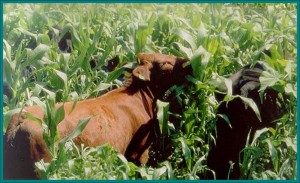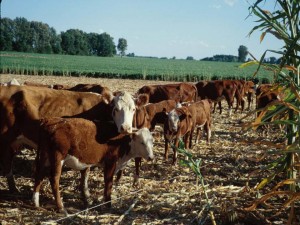In the past in this publication we’ve discussed the virtues of utilizing annual forages during the summer slump and late fall. In response, good friend Keenan Turner, retired Kentucky Pulaski County Extension Agent and Master Grazing Program Coordinator, shared with me some of the work he’s done with Kentucky graziers utilizing standing corn to fill in during this time of year when perennial forages are typically yielding little or going dormant.
Keenan tells me that most of the grazers in his area were feeding hay by the first of August this year, but, a couple grazers who seeded “bin-run corn” back in mid-April where grazing it at that time, instead. Over the years, Turner worked with his local cattlemen as they grazed several of the brassica’s along with rye, ryegrass, wheat, barley, triticale, in both the Spring and Fall. At the same time, they tried lots of the summer annuals including all the sorghums, sudans, sudangrasses, etc. They discovered that instead, bin-run corn was the cheapest and best yielding per acre, and also found that the cattle really kept their condition during the summer months on the grazing corn. While many of the cow herds in the area were Fall calvers, the Spring calving cows they did have milked well on the corn and maintained their condition with calves at side.
Early on, seed corn was planted in 36 inch rows for grazing. Turner tells me they later learned to go to the grain bin and use “bin-run corn” seeded at 2.5 to 3 bushels corn per acre either drilled in with a small grain drill or broadcast and disked.
Checking the germination on bin-run corn prior to seeding is a must. Corn which had high moisture going into the bin and had heat applied to dry it was at risk of having poor germination. Since they plan to graze it at 70-90 days after seeding, Keenan recommends only using around 70 pounds of actual nitrogen per acre.
When grazing, Turner recommends feeding Rumensin in the mineral to aid in the prevention of acidosis. This is regardless if grazing green corn or dried down standing eared corn.

